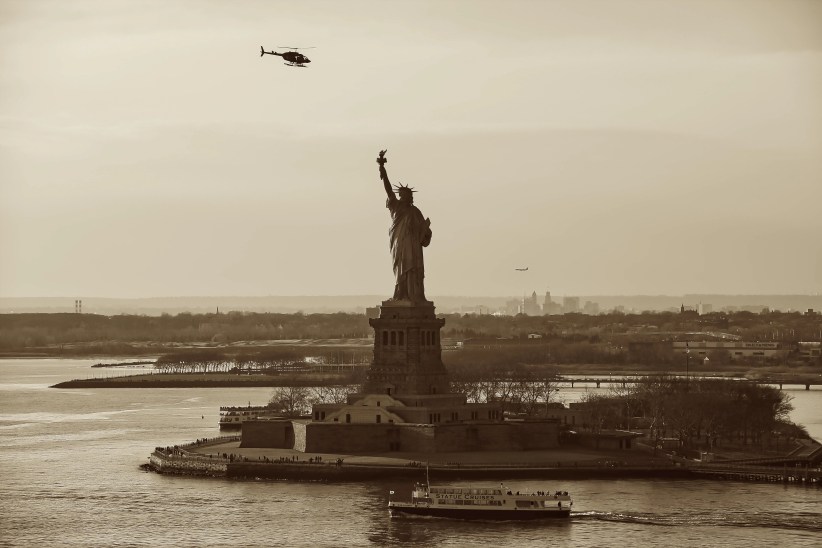
NYC Helicopter Crash: What to Say to Kids After Seeing Scary News About Air Crashes
Yesterday was one of those days that just felt overwhelming, even for adults. Two separate air travel accidents made headlines just hours apart, and they weren’t the kind of stories you can easily turn away from. For kids, it’s a bit harder. Like us, they’re seeing the videos on the news, hearing grown-ups talk, and picking up on the tension around them, even if they don’t fully understand what happened.
A sightseeing helicopter crashed into the Hudson River in New York City, killing all six people on board, including the CEO of Siemens Spain, his wife, and their three young kids. The family had just flown in from Barcelona that morning for what was supposed to be a fun trip. Photos showed them smiling and excited just before they boarded the helicopter. Then, something went wrong mid-flight, and suddenly the helicopter experienced a mechanical error that caused it to plummet into the Hudson River.
Psst… Check Out Helping Kids Make Sense of Today’s News: Expert Advice from Dr. Irina Gorelik
Just a few hours before that, at Ronald Reagan Washington National Airport, two planes, both carrying members of Congress, collided while taxiing. No one was hurt, thankfully, but it naturally shook people up, of course, especially since just two months ago, 67 people were killed when a commercial jet collided mid-air with an Army Black Hawk helicopter over the Potomac River, also in Washington, D.C.
For New York families, yesterday’s crash hit extra hard. It happened right here. New Yorkers, old and young, could have seen the helicopter flying in real time and recognized the skyline in the crash video. It was also just a few minutes away from crashing on the streets of Manhattan, potentially hurting or killing many more people.
How to Help Kids Process the Fear
To help kids process what they saw, start by letting them talk and really listen. “It’s scary for us, and it’s scary for kids,” says Dr. Irina Gorelik, a licensed psychologist who works with children and families. “If they have feelings and thoughts about it, it’s important to give that space.”
Don’t feel like you need to immediately fix their fear or jump in with statistics. Instead, just sit with them in the moment. You can say something like, “Yeah, that was really scary and really sad. I can understand why you’re feeling upset or confused.”
Answer Their Questions But Keep it Age-Appropriate
If your child asks, “Are planes safe?” or “Could that happen to us?” Dr. Gorelik says it’s okay to be honest while also keeping things reassuring.
Try something like: “That’s a good question, and I understand why you’re asking. Airplane and helicopter crashes are rare, even though they’re really scary when they happen.”
For little kids, you don’t need to go into a lot of detail. Just a simple, calm explanation might be enough. For older kids or teens, you can talk about how many safety checks and rules are in place to keep flights safe. You can point out how millions of people fly every day without anything going wrong.
Be Mindful of What They’re Seeing
The images and videos from these incidents are everywhere on TV, phones and social media. While adults might scroll past, kids can get fixated on them.
Instead of letting them absorb the scary stuff on their own, check in. Ask what they’ve seen, what they’ve heard, and what they’re wondering. Let them know they can come to you with anything.
Help Them Feel Safe Again
After something like this, even kids who didn’t seem scared at first might get nervous later, especially about flying, traveling, or even being far from home. Fear doesn’t always show up right away, and it also comes at a time when many families are getting ready for their spring break vacations.
Remind children of all the things that help keep people safe. Stick to routines. Make time to hang out, play, read, or just be together. Even something as simple as a bedtime story or a walk outside helps. Kids often look to the adults in their lives to understand how worried they should be so if you can stay calm and open, that helps them to feel safe again.
Ultimately, kids need to know it’s okay to feel what they’re feeling and that they don’t have to carry it alone. Let them ask questions. Let them be afraid. And then show them with your words, your hugs, and your presence that they’re safe, they’re loved, and you’ve got them.
Psst … Check Out 7 Safe and Credible News Sites for Children






